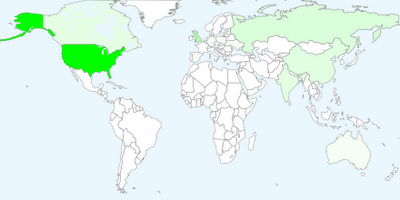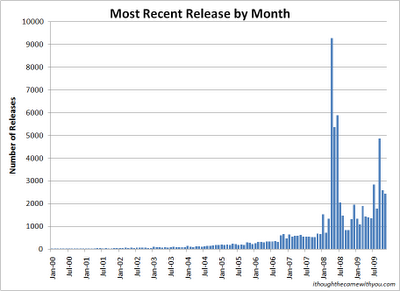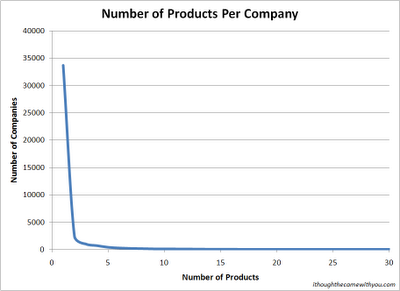State of the Micro-ISV-osphere
I was a micro-ISV (µISV) for years before I heard of the term. It was coined by Eric Sink to describe a one man software shop, and is now generally used for any small software company.
There isn't much market data available this far down the long tail so I've spent some time analyzing PAD files to see if I could answer a few questions.
PAD is the Portable Application Description specification from the Association of Shareware Professionals. It's used to describe software for submission to download sites. How useful these sites are is another question — read Scott Kane on this if you haven't already.
I spidered all the PAD files listed in the ASP directory, downloading data on 76,066 products from 39,861 µISVs (companies / people / publishers). It's not a perfect data set as there are PADs that aren't software and µISVs that don't use PAD. I've also heard that some people are developing web apps these days. But here goes…
Where are the µISVs?

Overwhelmingly in the US. Other countries with more than a thousand listed are the UK, Russia, China, India, Canada, Germany and Australia (in descending order). Most countries have at least one µISV but the numbers fall off pretty quickly.
How much do µISVs charge for their products?

$29.95.
About a third of products are free and a third fall into 9 price points (all ending in 5). I found over a thousand different US Dollar price points overall.
The most expensive product was a $150,000 Green Living site license from South Beach Software (an order of magnitude more expensive than the runner up).
How large are µISVs products?

There's not much action past 20 MB. Most downloads are between 1-2 MB. There's an interesting little spike around 14 MB. I guess this is a popular framework, possibly Java? The largest download was almost 1.5 GB.
Are µISVs still releasing downloadable software?

This is a tough one to get at because PAD files just tell you about the most recent version, not the release history. The chart really shows a last update distribution for the products in the PAD catalog.
There's a large number of products last updated in mid-2008 with nothing comparable in 2009. Could this be a drop-off in PAD usage? A shift to web apps? Maybe final releases before the recession hit leading to less spare cycles for side projects (my µISV certainly pays for beers rather than mortgages).
How many products do µISVs publish?

This final chart shows that most µISVs have just one product. Of course in some cases there might be a brand per product and still a single entity — it's impossible to separate this out from the PAD data. The largest number of products from a single µISV is 616.
Related Posts
- Licensing Fail: WinZip vs. ScanToPDF
- 1,000th Post!
- Automate Google PageSpeed Insights and Core Web Vitals (CrUX) Logging with Apps Script
- Pandemic Gas Mystery
- How to fix software patents
(Published to the Fediverse as: State of the Micro-ISV-osphere #etc #asp Data on micro-ISVs - small software publishers - generated from association of software professionals PAD files. )
Add Comment
All comments are moderated. Your email address is used to display a Gravatar and optionally for notification of new comments and to sign up for the newsletter.